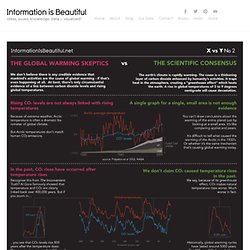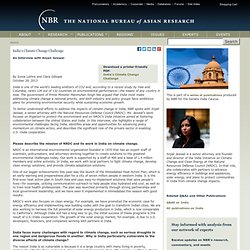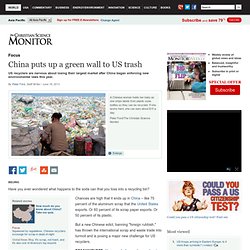

Climate Change Deniers vs The Consensus. Read about the background to this image | Leave a comment | See more visualisations and info images | Home UPDATE 1 (12th Dec 09): There have been a few complaints about the legibility of the image.

So I’ve created a version on white instead of black. UPDATE 2 (19th Dec 09): Thanks to amazing feedback, I’ve amended the language and wording and detail of the image. Thanks particularly to Arthur Smith and Jooil Kim for clarifying info. Nice! I researched this subject in a very particular way. Why? My conclusion is “what a nightmare”. Most of the info for this image is sourced from Realclimate.org.
Unfortunately, the majority of the writing on there is so scientific and so technical, it makes the website nigh on useless to the casual, curious reader. This image was a mammoth undertaking, especially for someone like me, unschooled in climate science. In every case, wherever possible, I went back the original data. Pollution Rising, Chinese Fear for Soil and Food. Is scarcity over? This morning, the Wall Street Journal described China's explosion in nickel pig iron production, which has sent global prices reeling by introducing a glut of cheap supply.

But it's not just nickel, the Journal reports. It's all kinds of commodities that we thought would start to disappear, and have instead started flowing even more freely, as producers found higher-tech ways of extracting them from the ground: Economists for years warned that rising demand for natural resources by China and other emerging markets would outstrip supply, leaving the world short of everything from nickel to coal, copper and corn.But a remarkable period of innovation and investment has produced a far different picture.
Expanded supply has helped moderate commodity prices over the past year after a decade of demand from China helped push many prices into the stratosphere.... Of course, price declines are also driven by weaker demand, especially in China, where economic growth has slowed. Facing Nature's Wrath: Dealing with Climate Change and Its Effects. Untitled. Fresh Air by 2030. PES_2013_report.pdf. Coal to outweigh oil in five years' time. Coal will surpass oil as the world's dominant fuel by 2018, and the mainland will be the dominant contributor to the development, an energy consultancy said.

The prediction highlights the difficulty to rein in reliance on pollution-prone coal, given its relative abundance and economic attractiveness. "China and India's aggressive power requirements will be responsible for coal's burgeoning role in energy, but the United States, Europe and [the rest of] Asia will still contribute to coal demand," said London-based Wood Mackenzie's president of global markets William Durbin at the sidelines of the World Energy Congress.
Oxford Analytica - Oil sector reform comes back onto Beijing's agenda. India's Climate Change Challenge. An Interview with Anjali Jaiswal By Sonia Luthra and Clara Gillispie October 29, 2013 India is one of the world’s leading emitters of CO2 and, according to a recent study by Yale and Columbia, ranks 126 out of 132 countries on environmental performance—the lowest of any country in Asia.

The government of Prime Minister Manmohan Singh has argued that India must make addressing climate change a national priority, and both industry and policy groups have ambitious plans for promoting environmental security while sustaining economic growth. To better understand efforts to address the impacts of climate change in India, NBR spoke with Anjali Jaiswal, a senior attorney with the Natural Resources Defense Council (NRDC). Ms. Economics of Climate Change in East Asia - economics-climate-change-east-asia.pdf. China puts up a green wall to US trash. Have you ever wondered what happens to the soda can that you toss into a recycling bin?

Skip to next paragraph Subscribe Today to the Monitor Click Here for your FREE 30 DAYS ofThe Christian Science MonitorWeekly Digital Edition Chances are high that it ends up in China – like 75 percent of the aluminum scrap that the United States exports. Or 60 percent of its scrap paper exports. But a new Chinese edict, banning "foreign rubbish," has thrown the international scrap and waste trade into turmoil and is posing a major new challenge for US recyclers.
Water in China: Desperate measures. China: The electronic wastebasket of the world. Did you ever wonder what happens to your old laptop or cellphone when you throw it away?

Chances are some of your old electronic junk will end up in China. According to a recent United Nations report, "China now appears to be the largest e-waste dumping site in the world. " E-waste, or electronic waste, consists of everything from scrapped TVs, refrigerators and air conditioners to that old desktop computer that may be collecting dust in your closet. Many of these gadgets were initially manufactured in China. Through a strange twist of global economics, much of this electronic junk returns to China to die.
"According to United Nations data, about 70% of electronic waste globally generated ended up in China," said Ma Tianjie, a spokesman for the Beijing office of Greenpeace. For the past decade, the southeastern town of Guiyu, nestled in China's main manufacturing zone, has been a major hub for the disposal of e-waste. Dirty, dangerous work. Global Natural Gas Vehicle Growth.